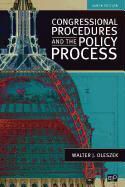Read more
As a governing body, Congress continually adapts to changes in process and practice. This procedural context governs every aspect of the House and Senate and affects lawmakers as they make voting decisions, expedite or delay legislation, or defeat a bill. Walter Oleszeks definitive work examines how the majority and minority parties use procedural devices to achieve their political goals and offers an assessment of the role of conference committees in reconciling bicameral differences. Not shying away from the complexity of the topic, Oleszek ensures that the machinations of Congress are understandable through an array of interesting examples, cases, and anecdotes that he is well-positioned to witness and experience first-hand.
List of contents
1. Congress and Lawmaking
2. The Congressional Budget Process
3. Preliminary Legislative Action
4. Scheduling Legislation in the House
5. House Floor Procedure
6. Scheduling Legislation in the Senate
7. Senate Floor Procedure
8. Resolving House-Senate Differences
9. Legislative Oversight
10. A Dynamic Process
About the author
Walter J. Oleszek is a senior specialist in the legislative process at the Congressional Research Service. He has served as either a full-time professional staff aide or consultant to every major House and Senate congressional reorganization effort beginning with passage of the Legislative Reorganization Act of 1970. In 1993 he served as Policy Director of the Joint Committee on the Organization of Congress. A longtime adjunct faculty member at American University, Oleszek is a frequent lecturer to various academic, governmental, and business groups. He is the author or co-author of several books, including Congress and Its Members, 13th ed. (2011), and Congress under Fire: Reform Politics and the Republican Majority, with C. Lawrence Evans (1997).

